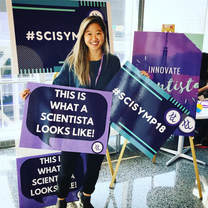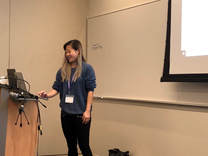|
By Robbin Koenig
You are building a website for your lab, new start-up, a personal CV for prospective employers/graduate school, or to educate the public about your passion for specific issues in science. Perhaps, you are considering creating a digital product. How do you get started? To be effective, the website needs to be organized, easy to navigate, intuitive, and visually appealing. The first stage involves determining the contents for inclusion in the website and then logically organizing this information. This leads to UX design, short for “user experience.” UX involves a multidisciplinary approach to design, encompassing graphic arts, strategic planning, visual composition, and technology. The process entails combining visual communication with information architecture, while aiming for enhanced findability for the website user. Since design is this writer’s weak spot, I eagerly attended Stella Kim’s workshop, “An Intro into UX” at the 2018 Scientista Symposium in April. Stella Kim is one of the founders of Mixlab, a compounding pharmacy that provides pharmaceuticals for veterinarians and pet owners. Kim’s interactive presentation targeted students who were considering UX design as a career goal, as well as, professionals who wanted greater insight into developing a DIY website or for aggregating background knowledge about website design before hiring a professional UX designer.
According to Kim, professional UX designers come from all different backgrounds. Before entering the field of UX, Kim held positions as an artist, fashion print designer, engineer, reader for films, game designer, and technical producer. “UX is unique because it is so multidisciplinary. We come from all different backgrounds. I've met UX designers that were once upon a time lawyers, aerospace engineers, chefs, artists, architects, mechanical engineers, environmentalists, financial analysts, and more. I’ve always thought UX designers shared a similar thirst for problem solving - not a background or degree, just a general curiosity to understand and solve problems,” expounds Kim. Problem-solving Is the core of UX design. Designers collaborate with shareholders (clients), engineers, and visual designers to address the needs of clients who obviously want their users to have a high comfort level with the site. According to Kim, “the key questions a UX designer needs to think about are: Does it help achieve the business goals? Is it easy to use? Does it make you feel good?” Kim states, “I like to think of UX designers as the peacemaker. You are often the middle person between shareholders, engineers, and visual designers. The shareholders represent the business and they tell you what their business goals and needs are. The engineers build the foundation, system, and architecture you design. The visual designer takes your wireframes and makes it beautiful and fluid. When you think about it, it’s similar to building a house. But instead of a house, we’re building a product.” UX designers use wireframes, a visual schematic that represents the layout and framework of the website. It converts the customer’s specifications into a visual landscape. During Stella Kim’s workshop, she invited members of the audience to create their own wireframes of an existing website using markers and whiteboards. This exercise helped the audience to understand the process of mapping out the website. “Bare bone wireframes consist of lines, boxes and circles. Not exactly rocket science. The real skill is solving and designing complex features and information architectures so they are simple for the user,” says Kim. Rather than create a storyboard by hand, some designers rely on prototyping tools. Kim provided the audience with a list of the prototyping tools most commonly used, including Sketch, Adobe, Framer, and Invision. Different tools offer different options and the final choice depends on the needs of the designer. Some are more suited for creating a design used on a mobile device or for someone with a limited budget and expedited deadline. Others offer placeholders where the content can be added later. Prototyping tools can be used to test different ideas. According to Kim, “You need to always remember that you are the expert. Part of our job is to educate the client. Every decision you make as a UX designer should be able to be backed up with good reason, so make sure you do your research and you're always keeping up with what's going on within UX. Sometimes, you'll want to really push the boundaries and go where no UX designer has ever gone before and that's great! That's the dream! Just make sure you test your ideas. These days, with so many prototyping tools, testing ideas quickly is quite easy and every UX designer should take advantage of the resources they have available to them. You don't need to know computer science to be a UX designer, although having some knowledge of it is definitely helpful.” Researching and thoroughly understanding the product or website topic is also a necessity. Developing some expertise and acquiring a solid knowledge-base are integral components for creating an effective and functional design. Kim asserts, “I think it's really important to be part of product research and testing at some point in your career. It gives you great insight into overall product development and the experience is invaluable. Understanding your user and what they want/need is absolutely key to designing a good product. If you don’t understand what or why you’re designing something, chances are your user won’t either.” Currently, Kim’s focus is entrepreneurship as the CXO (Chief Experience Officer) at Mixlab. She designs and manages all the digital products, oversees both print and digital branding, and helps with day-to-day operations. “Being so involved in everything from the beginning allows me to understand how and where we can improve and streamline our growth. This entails customer service, tracking orders and deliveries, packaging, billing, and inventory management. On occasion, but rarely, I’ll put on gloves and help make treats (which I secretly quite enjoy). I also manage our social media platforms, attend events and build relationships with rescues,” says Kim. Kim used her personal experience to develop the company. “The journey continues to be one of the greatest adventures of my life. You could say I grew up in pharmacy. My father and oldest brother are both pharmacists and we have a small family pharmacy in Spanish Harlem. Working in tech, you see industries across the board being disrupted. I started looking at the future of pharmacy and then coincidentally the universe brought my cofounders and I together.” Kim also applied her problem-solving skills in UX design to building her business. Comparable to to her responsibilities in UX projects, Kim and her team identified a problem and worked on solving the issue. “We’re a group of pet lovers that felt pets weren’t getting the health and wellness they deserved. More than 2/3 of US households have a pet (that’s more than children!). The pet pharmacy experience is just terrible and we’ve experienced it firsthand. Given our backgrounds, we knew we could do it so much better and that’s why we started Mixlab!” says Kim. Collaboration and cooperation, essential features for success in the UX design field, are also critical features for building a new business. Kim claims, “Anyone, whoever decides to build a company, I cannot stress enough the value of finding the right partners. I feel extremely lucky and grateful to have met people, who not only shared similar frustrations in the space, but saw the business opportunity, the value in our partnership, and understood what it was going to take from each of us to succeed. I think a common mistake is that people feel they need to be able to do everything. Someone who can do a little bit of everything is an expert in nothing. Focus on your strengths and find the right partners that have strengths in other areas. Both my partners bring so much talent, expertise, and knowledge in areas I lacked. I'm only able to build Mixlab because I have a solid foundation to build upon and that's my team.” 
About the Author
Robbin Koenig, M.A., M.S. is an educator with an avid interest in technology and science education. She has taught students in prekindergarten through high school. Robbin enjoys volunteer work, exploring the N.Y.C. cultural arts scene, and anything pertaining to wildlife. Comments? Leave them below!
1 Comment
9/13/2021 10:31:13 am
You literally made my day happy by sharing this wonderful blog. Keep it up, thanks.
Reply
Your comment will be posted after it is approved.
Leave a Reply. |
CONNECT WITH USSUBSCRIBE |
The Scientista Foundation, Inc. All Rights Reserved © 2011-2021 | Based in NY | [email protected]
The Network for Pre-Professional Women in Science and Engineering
The Scientista Foundation is a registered 501(c)(3) -- Donate!
The Network for Pre-Professional Women in Science and Engineering
The Scientista Foundation is a registered 501(c)(3) -- Donate!




 RSS Feed
RSS Feed